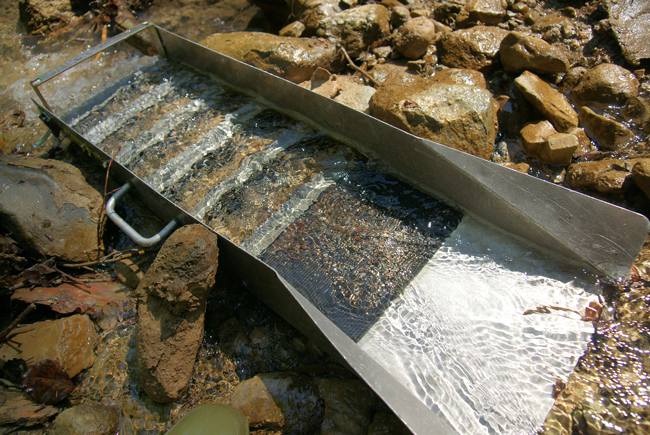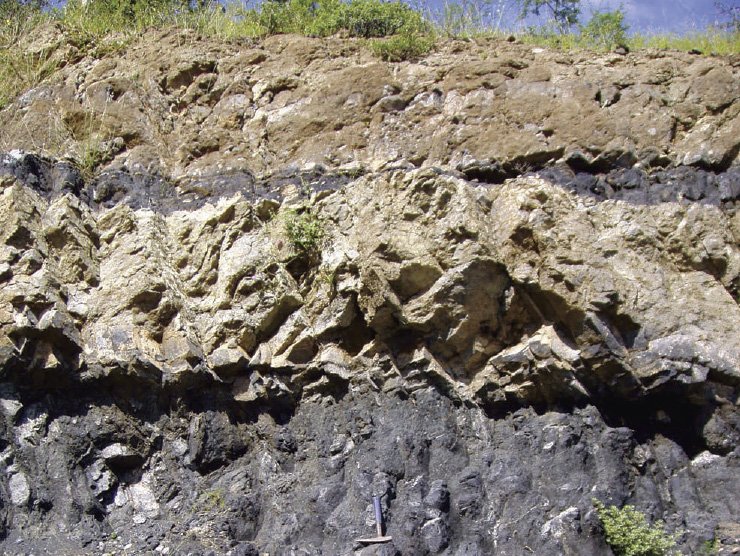Balmoral has an interesting property here and some decent gold projects in their portfolio, but I suspect the recent stock price run-up has a lot to do with surging nickel prices which this month reached a two year high.
[box type=”info” align=”aligncenter” ]Disclaimer: This is an editorial review of a public mining company press release and is not an endorsement. It may include opinions or points of view that may not be shared by the companies mentioned in the release. The editorial comments are highlighted so as to be easily separated from the release text and portions of the release not affecting this review may be deleted. Read more at How to Use this Site.[/box]
VANCOUVER, BC–(Marketwired – May 20, 2014) –
- Intersects 45.28 metres grading 1.79% Nickel, 0.19% Copper, 0.42 g/t Platinum and 1.04 g/t Palladium
- Includes 17.60 metres grading 2.45% Ni, 0.31% Cu, 0.62 g/t Pt and 1.57 g/t Pd
Balmoral Resources Ltd. (“Balmoral” or the “Company”) (TSX: BAR)(OTCQX: BALMF) today confirmed the discovery of high-grade nickel-copper-PGE mineralization associated with the previously highlighted (see NR14-09, April 30, 2014) net textured sulphide zone in hole GR-14-25. The net textured zone, one of four mineralized intervals in the hole, returned a near surface intercept of 1.79% nickel, 0.19% copper, 0.42 g/t platinum and 1.04 g/t palladium over 45.28 metres. This high-grade interval is capped by, and includes, 1.11 metres of massive to semi-massive sulphide which returned 10.60% Ni, 0.45% Cu, 2.04 g/t Pt and 5.23 g/t Pd, confirming the potential for very high grade nickel and PGE values within the system (see table below).
[box type=”note” align=”aligncenter” ]
Recent results from junior explorer Balmoral Resources have created quite a stir in an otherwise quiet junior mining sector. The stock was trading $1.20 as of writing which is more than double its YTD low of $0.52.
Let’s take a look at the data and get to the bottom of all this buzz.
[/box]
Hole GR-14-25 is the first hole on the property to intersect Horizon 3 of the Grasset Ultramafic Complex . This newly discovered, sulphide rich horizon is open in all directions and sits approximately 100 metres southwest of, and stratigraphically above, two other vertically oriented Ni-Cu-PGE mineralized horizons within the southern-most portion of this sparsely tested, up to 16 kilometre long, ultramafic sill complex.
[box type=”note” align=”aligncenter” ]
The last time we talked about Balmoral Resources, they were completing some geophysical surveys on their “surprise” nickel-PGM prospect which was discovered while drilling for gold on the property. This release deals with some drilling on that prospect.
The Grasset Property is situated along the “Sunday Lake Deformation Zone (SLDZ)” within the Abitibi Greenstone Belt. The Abitibi Greenstone Belt is not only known for it’s world class VMS deposits but also contains several world class gold districts. The SLDZ in particular is considered an excellent area for hosting structurally controlled deposits. This area isn’t exactly unknown territory for there are numerous past Gold, Copper, Zinc mines along the Casa Beradi Fault 40 km to the south of the SLDZ. Balmoral’s nearest neighbor, Detour Lake Mining, a large producer that currently operates the Detour Lake Gold Mine 80km to the east of the Grasset Property is an example of that.[/box]
| Hole Number | North | West | Dip | From (m) | To(m) | Inter- val*(m) |
Ni(%) | Cu (%) | Ptg/t | Pdg/t | Hori- zon |
| GR-14-22 | 0+90 S | 2+60 E | -57 | 141.23 | 173.97 | 32.74 | 0.47 | 0.05 | 0.11 | 0.26 | 2 |
| GR-14-23 | 0+90 S | 2+60 E | -64 | 170.53 | 182.44 | 11.91 | 0.49 | 0.05 | 0.11 | 0.25 | 2 |
| GR-14-24 | 1+30 S | 7+20 E | -57 | 168.20 | 185.51 | 17.31 | 0.32 | 0.04 | 0.05 | 0.11 | 2 |
| GR-14-25 | 1+30 S | 5+20 E | -61 | 79.62 | 156.91 | 77.29 | 1.17 | 0.12 | 0.25 | 0.62 | 3 |
| * All intercepts reported are down hole lengths, not true thicknesses. Insufficient drilling has been completed to date to define the orientation of the mineralized zone in space |
[box type=”note” align=”aligncenter” ]Although these results appear quite promising we once again have to remind ourselves the devil is in the details and understand what these number mean. These were reported as “down hole lengths” and do not reflect the true thickness of the mineralized horizons. As shown in the cross-section diagram below, the drill intersected the horizons at a fairly shallow angle. Still, the results include significant intervals of nickel and PGM‘s. While this might not have been as exciting six months ago, surging nickel prices are reigniting interest in these types of deposits. [/box]
The 45.28 metre net-textured interval in GR-14-25 exhibits excellent internal continuity and uniformly exhibits strong nickel and PGE grades. Today’s results also confirm the presence of nickel-copper-PGE mineralization for over 840 metres laterally, and 300 metres vertically, along Horizon 1; and for over 540 metres laterally and 240 metres vertically along Horizon 2. The first test of Horizon 3 was hole GR-14-25 which intersected the high-grade mineralized zone at less than 100 metres vertical depth. All three mineralized horizons remain open in all directions, save Horizon 1 which appears to be terminated by the Sunday Lake Deformation Zone to the south. Massive nickel-copper-PGE bearing sulphides have been intersected along both Horizon 1 and Horizon 3 in the limited (10 holes) drilling completed to date.
The host Grasset Ultramafic Complex is interpreted to stretch for 16 kilometres across Balmoral’s wholly owned Grasset and Fenelon Properties. It has seen only limited drilling, focused primarily in an area 8.3 kilometres northwest of the current discovery. Similar nickel-copper-PGE sulphide mineralization is known to occur in this area, suggesting significant potential for additional discoveries along the length of the Complex.
[box type=”note” align=”aligncenter” ]
When it comes to exploration a “geological marker horizon” is a useful tool for extrapolating the potential extent of the mineral resource. In this case the resource appears to be stratabound, or confined to a particular geologic unit. In this case that unit is Grasset Ultramafic Complex. Balmoral is suggesting that since nickel-copper-PGE sulphide mineralization is known to occur along the same unit 8.3 km (~5 miles) away and that the unit extends for 16 km (~10 miles) there is potential for significant discoveries along trend.
This style of mineralisation is common in other magmatic layered mafic intrusions such as the Bushveld Igneous Complex (South Africa), the Sudbury Igneous Complex (Ontario, Canada) and the Ring of Fire (Ontario, Canada); which can be traced for several kilometers.
[/box]

Recently received thin section analyses indicate the presence of abundant pyrrhotite and pentlandite, with lesser chalcopyrite, magnetite (after chromite), pyrite and millerite (the latter a nickel sulphide with strong nickel tenure) within the high-grade, net textured zone. Pentlandite, which appears to host the bulk of the nickel mineralization, occurs as isolated mineral grains which the Company believes to be favourable from a metallurgical viewpoint.
[box type=”note” align=”aligncenter” ]
Thin-section analysis is the microscopic examination of a micron-thin slices of rock. Using thin section analysis, the company has identified the various minerals present in the rock. While geochemical assays will always give the total content of various elements within a rock, they don’t tell you what minerals are hosting the metals. This can make a big difference when it comes to metal extraction: A commodity hosted in a silicate mineral, for example, would not likely be economic while the same commodity hosted in a sulfides or oxides is relatively simple to extract and more likely to be economic.
In this case, they have identified several nickel-bearing sulfide minerals including pentlandite (nickel-iron sulfide) and millerite (nickel sulfide).
[/box]
The Company anticipates that drilling and geophysical work on the Grasset Property will resume, ground conditions permitting, in mid-June, followed shortly thereafter by the resumption of drilling on Balmoral’s Martiniere high-grade gold property 40 kilometres to the west.
“The broad, high-grade nature of the Grasset Ni-Cu-PGE discovery provides Balmoral with a second exciting, near-term growth opportunity in Quebec” said Darin Wagner, President and CEO of Balmoral Resources. “With recent price increases demonstrating the sensitivity of the nickel market to political uncertainties in major producing regions, the lack of new nickel discoveries globally over the past several years, the strength of the grades, wide nature of the intercepts, significant PGE content and apparent scale of the mineralized system, the Grasset discovery would appear to position the Company to attract significant interest from investors in both the precious and base metal sectors.”
[box type=”note” align=”aligncenter” ]
So we’re back to our first question. Why all the buzz? Intriguing nickel and PGM intersections and a large exploration area have no doubt have helped, but the grades are not what we would call high. Balmoral has an interesting property here and some decent gold projects in their portfolio, but I suspect the recent run-up has a lot to do with surging nickel prices which this month reached a two year high.
[/box]
[box type=”success” align=”aligncenter” ]Have a company or release you’d like us to look at? Let us know through our contact page, through Google+, Twitter or Facebook.[/box]






